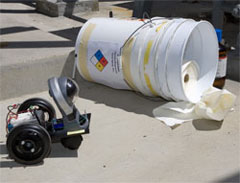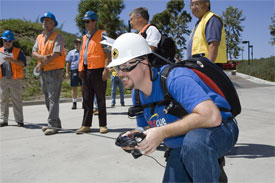Evac-Pack Turns Humans into Sensors
|
Oct. 24, 2006 – It looks like futuristic hiking gear. Instead, the Evac-Pack contains high-tech tools that one day may save lives in a high-rise building.
The wearable, wireless, multimodal communication system will enable first-responders in emergency evacuations to maintain constant two-way communication with an emergency operations center.
Gearing Up
The GPS/Bluetooth-equipped apparatus consists of a backpack-transported computer, video camera, wearable keyboard and wireless mouse. An eyeglass-mounted visual display, and full-duplex audio microphone and earpiece enable the wearer to communicate in real-time with crisis managers in emergency control centers. A gas sensor detects and communicates levels of oxygen, carbon monoxide and other gases present in an environment, while an avionics-designed helmet incorporates compass, accelerometer and thermometer to transmit images and data back to the control center.
The prototype device is powered by two independent 12-volt power supplies.
ResCUE principal investigator Sharad Mehrotra conceived the apparatus; Chris Davison, ResponSphere’s technology manager, assembled it using off-the-shelf components.
The prototype grew from an earlier iteration that incorporated a Compaq i-PAQ pocket PC and a set of goggles. The mini-Evac-Pack system could send information from a control center to the i-PAQ, but could not allow two-way communication.
Two-Way Communication Aids Rescue Effort
“Evac-Pack employs ‘human-as-sensor’ technology that benefits first responders in emergency situations as well as crisis control centers trying to analyze the extent of a disaster,” Mehrotra said. “It helps get important information to the right people as quickly as possible.”
|
||||
In wired “smart buildings,” instrumented with an 802.11 network layer, the system can “push” a map of each floor into the wearer’s eyepiece, with blue dots indicating occupied rooms and movement of occupants. This continually updated map can save the rescuer valuable time by prioritizing room-to-room searches.
“In an evacuation, floor wardens go room-to-room, searching for stragglers,” Davison says. “Evac-Pack allows them to do an intelligent search, cutting search time tremendously.”
Adding an 802.11 router card and a CDMA data card allows information to be transmitted outdoors over Verizon local networks. This feature allows the Evac-Pack wearer – aided by remote-controlled autonomous sensing platforms that beam real-time video images from crisis sites – to view potentially dangerous situations from afar.
Evac-Pack has been tested in numerous emergency drills, most recently a replicated chemical spill on the Hewitt Hall loading dock. In that exercise, a remote-controlled sensing platform was dispatched into a fenced area, where it took video images of the spill and sent them directly to the Evac-Pack-wearing first-responder. From the images, the responder was able to determine that the spill was only moderately toxic – knowledge that influenced his actions.
“This was a great example of the partnership between technology and first-responders,” says Davison. “The information gleaned as a result of this technology impacted the first-responder’s decision-making process.”



